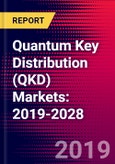Quantum Key Distribution (QKD) is one of two encryption technologies designed to protect critical data in the quantum era. QKD– in theory at least – leads to intrinsically unbreakable data transmission. When the researcher published its first report on QKD a few years ago, QKD was mostly experimental and aimed at government/military markets. However, as discussed in this new QKD report, the addressable market for QKD is expanding from specialized projects sponsored by governments and the largest financial institutions to large data centers, of which there are a large and growing number.
This report identifies the revenue generation opportunities from Quantum Key Distribution and provides market forecasts for the next decade. These forecasts are in both volume and value terms and include both QKD equipment, component-level products and related networking products. Each of the forecasts is also broken out by product and technology type, application and end-user industry, geography and location of end users. Throughout the report, we have discussed the role of China in the QKD, since that country has made itself one of the key regions for technological advance and deployments of QKD.
Strategic profiles of all the leading firms supplying QKD systems and related components are also provided. In these profiles we discuss how each firm regards the current state of the QKD market and how they expect it to develop. We also examine their sources of finance and how they plan to develop their products over the next few years. The report also examines the latest R&D into QKD and how this will impact the commercial quantum encryption market and the development of QKD products.
This report will be essential reading for product, marketing and strategy executive throughout the entire encryption sector, including QKD systems makers and providers of encryption software of all kinds. It will also be of considerable interest to investors in the QKD space.
Table of Contents
Companies Mentioned
- ABB (Acquired Keymile)
- Anhui Qasky
- Fujitsu
- IBM
- ID Quantique
- KETS quantum Security
- KPN
- MagiQ Technologies
- Mitsubishi
- Nippon Telegraph and Telephone (NTT)
- Nokia
- Nucrypt
- Oki Electric
- Post Quantum
- QinetiQ
- QuantumXchange
- Qubitekk
- QuintessenceLabs
- Raytheon
- SK Telecom
- SeQureNet
- Toshiba
- Universal Quantum Devices
- ZTE
Methodology

LOADING...








